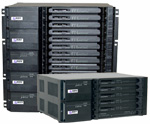| MRV Products Network 9000 Modular Console Server, Alarm Management  The Network 9000 chassis family provides support for a wide range of networking interface modules that are interchangeable between 3-slot, 6-slot and 15-slot chassis. The Network 9000 provides network administrators with the flexibility to create application-specific configurations. To meet the critical and wide-ranging roles that hubs serve in today's networking infrastructures, the Network 9000 has been engineered to provide redundancy and fault tolerance in critical applications. Ease of maintenance features such as hot swapping of components and automatic module reconfiguration minimize network downtime. A range of power and density options meets the requirements of all types and sizes of networks. Midplane Architecture The midplane architecture of the Network 9000 eliminates the restrictions of traditional backplane-based hubs. Network administrators can mix and match I/O modules with processor modules. Processor and I/O modules connect at the midplane of the chassis and a pair typically occupies one full slot. The midplane design provides greater flexibility in the selection of connectors and I/O options, ease of maintenance and module replacements, simplified sparing, and exceptional flexibility. The Network 9000 midplane supports three 10-Mbps shared Ethernet segments. Each shared media network is available from every slot. The midplane also includes a local management bus connecting to all installed modules. Reliability and Maintenance The Network 9000 is engineered with a number of features that enhance reliability. Hot Swapping - Modules, most redundant power supplies, and cooling fans can be replaced without powering down the unit or interrupting the network. When modules are swapped, the new module is automatically configured with the parameters of its predecessor. Cooling Design - Network 9000 chassis fans provide more than enough cooling capacity so that the unit can operate even if one or more fans fail. Fans are mounted on slide-in assemblies for quick replacement. LEDs - Status LEDs on the front of each processor module allow a network administrator to quickly determine the status of the processor module and the interface connections on its companion I/O module. Distributed management - The SwitchPlane contains a dedicated management bus to which all modules in the chassis are connected. SNMP and RMON agents reside on the individual modules. Through the management bus, a single processor module can provide management access to all other components in the chassis - even if the network is down. Software loading - Multiple software loading options ensure that network administrators can load software to Network 9000 modules from multiple sources, a useful feature for performing software upgrades and for rebooting after a failure or module swap. Processor modules also support loading from a network-based load server such as a workstation-based host. The network administrator can load software images over local or wide area networks, allowing centralized distribution of updates and ensuring that all units use the correct software. Power Systems Six and Fifteen slot Chassis The 6 and 15 slot chassis use interchangeable power supply modules, simplifying sparing. The power supply system supports AC or DC operation. The redundant version of the AC/DC power supply system for the 15-slot Network 9000 unit allows for connections to separate AC/DC power grids, eliminating the power source as a single point of failure. As critical components of the network architecture, these power supplies are also manageable. Any Network 9000 processor module allows the 6- and 15-slot power supplies to be managed via SNMP, a local console or Telnet. Network administrators need only purchase the minimum number of power supply modules required to support the modules installed in the chassis. Additional power supply modules may be added for redundancy or as additional processor and I/O modules are installed. Adding a second or third power supply to a Network 9000 6- or 15-slot chassis does not require using another module slot, as is often the case in a competing product. The AC and DC controller modules provide nonvolatile storage of module configurations. When aprocessor or I/O module is replaced, each retains the network address of its predecessor. An entirely new chassis can be given the attributes of an existing chassis by moving the original controller module into the new chassis, greatly reducing the configuration overhead when replacing or upgrading a chassis. |
MRV Products By Category Out-of-Band Console & Power Management Pluggables Wave Division Multiplexing By Product Line OptiSwitch TereScope In-Reach
Products
 |